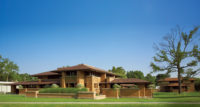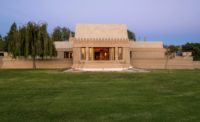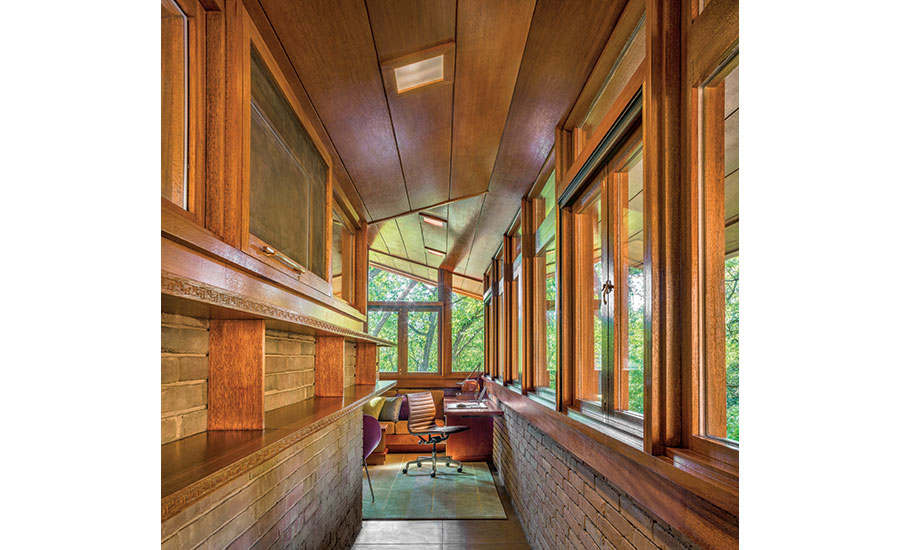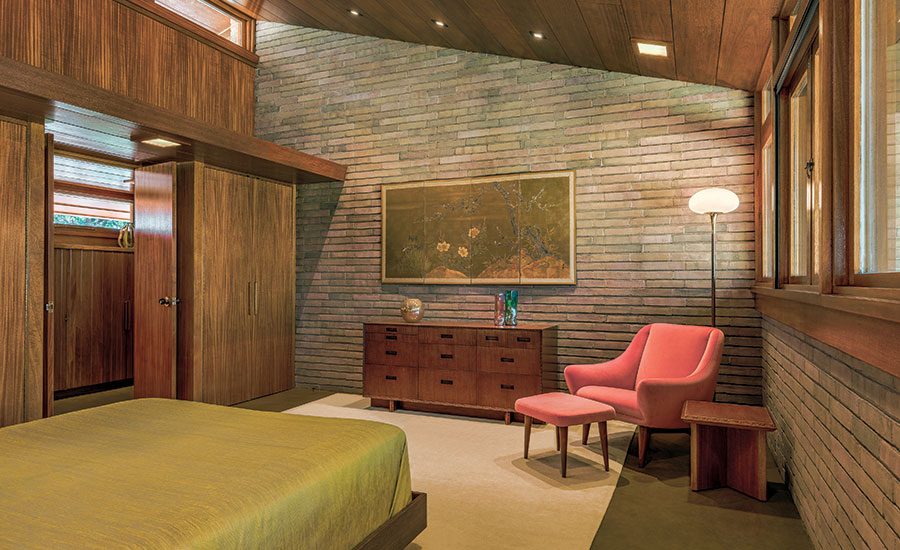Fredrick House by Frank Lloyd Wright
Barrington Hills, Illinois
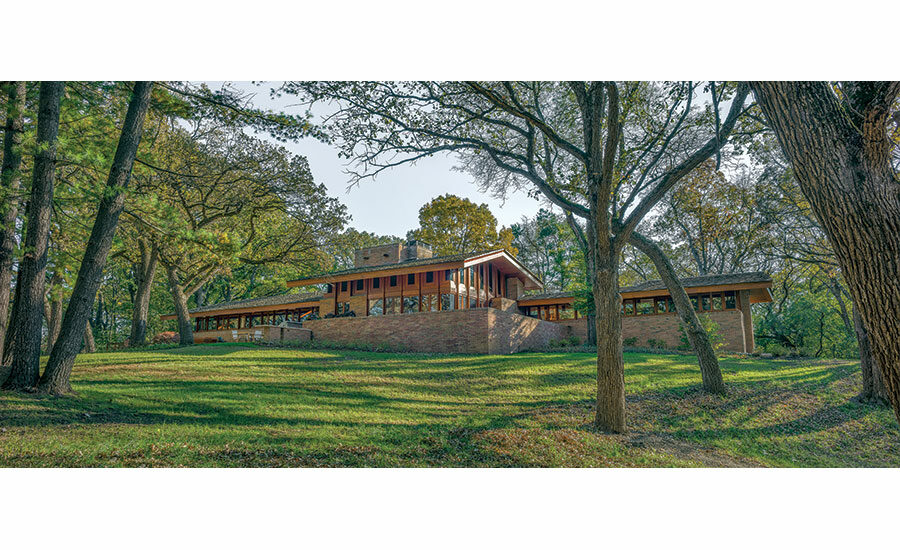
The low-slung house has a daylit corridor along the bedrooms and entrance and, at the other end, a long gallery leading to the study.
Photo © James Caulfield
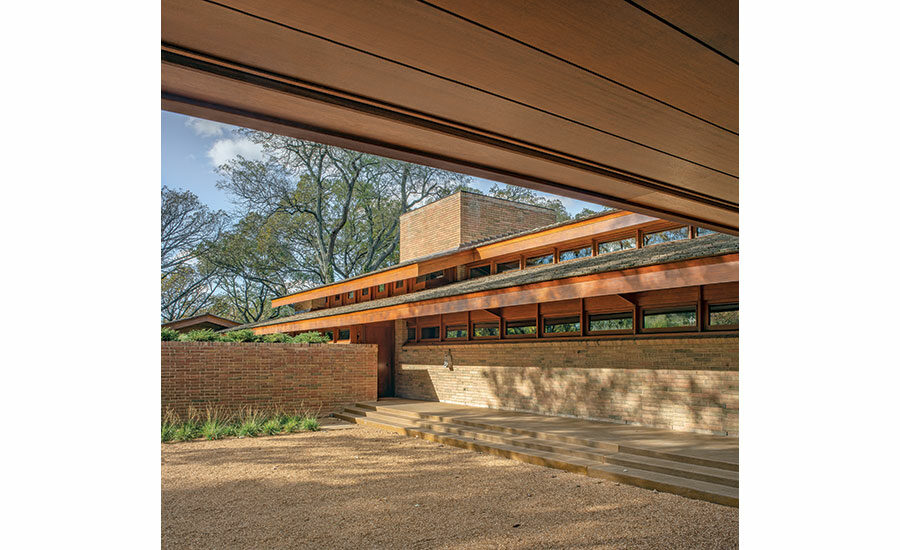
Instead of stucco, Fredrick requested Norman (or Cranbrook) brick, as used by Eliel Saarinen at Cranbrook.
Photo © James Caulfield
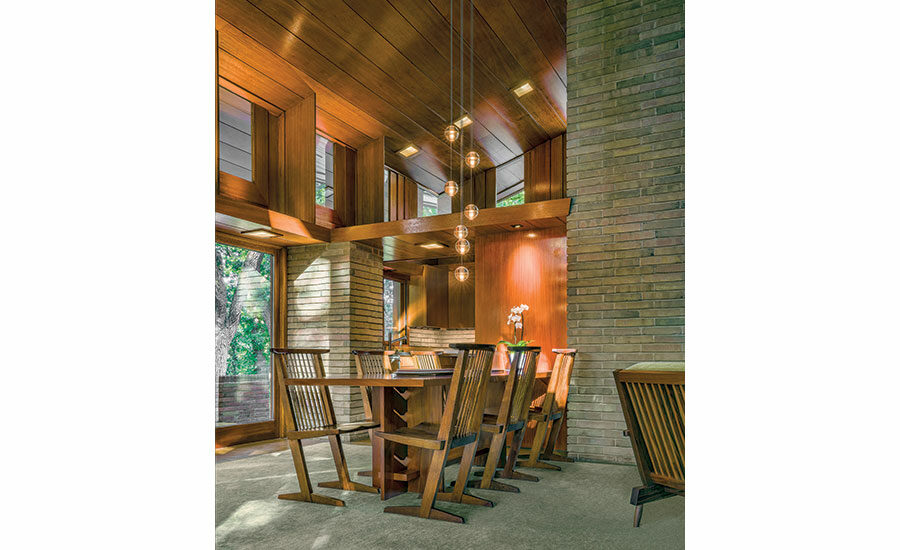
Throughout the interior, the renovation restored Philippine mahogany and radiant-heated concrete floors—as seen in the dining area (shown), living room, bedrooms, and light-filled corridor leading to the study.
Photo © James Caulfield
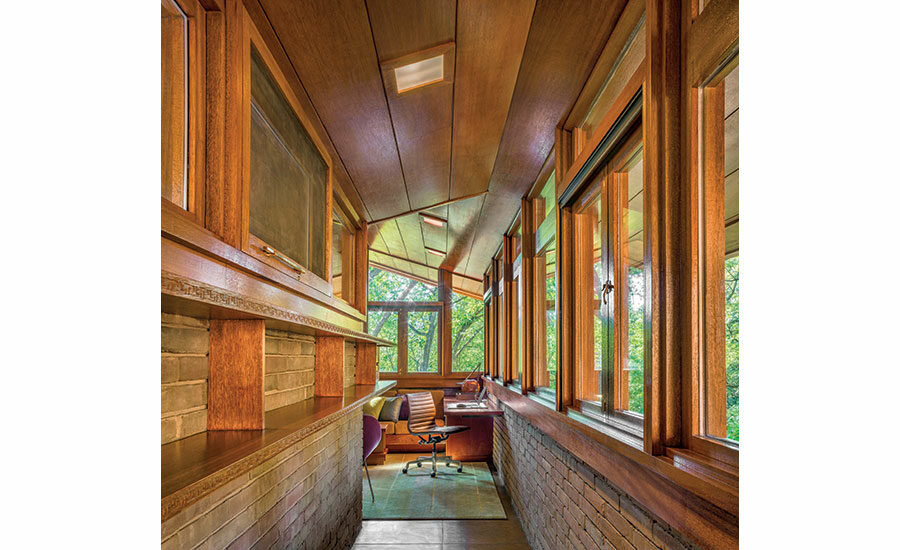
Throughout the interior, the renovation restored Philippine mahogany and radiant-heated concrete floors—as seen in the dining area, living room, bedrooms, and light-filled corridor (shown) leading to the study.
Photo © James Caulfield
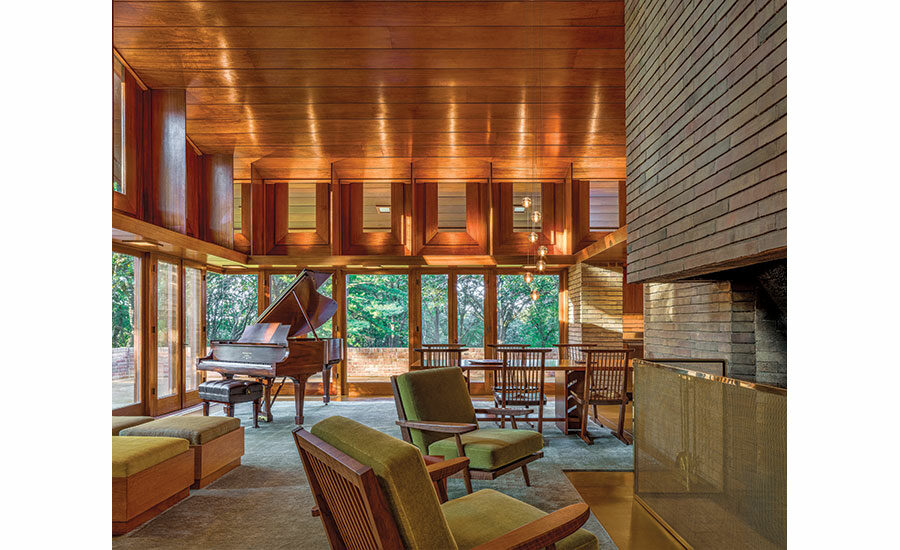
Throughout the interior, the renovation restored Philippine mahogany and radiant-heated concrete floors—as seen in the dining area, living room (shown), bedrooms, and light-filled corridor leading to the study.
Photo © James Caulfield
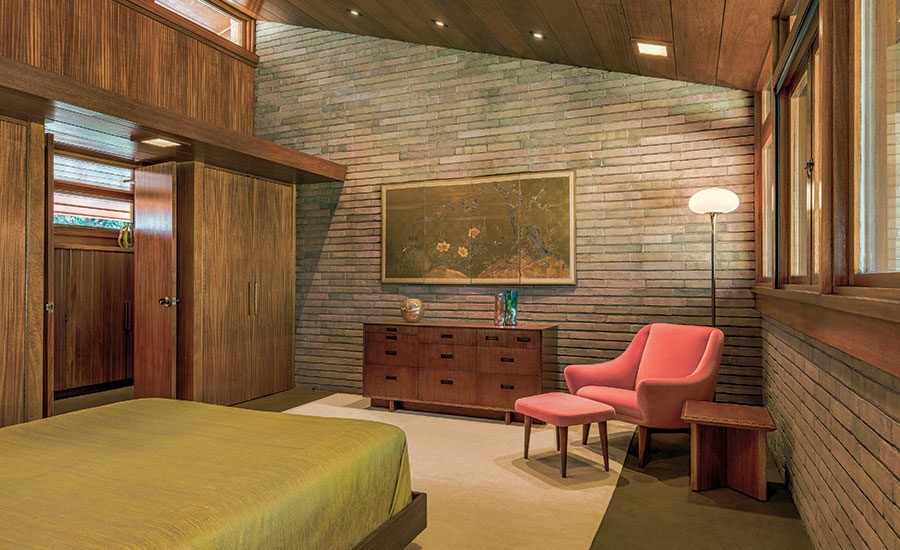
Throughout the interior, the renovation restored Philippine mahogany and radiant-heated concrete floors—as seen in the dining area, living room, bedrooms (shown), and light-filled corridor leading to the study.
Photo © James Caulfield
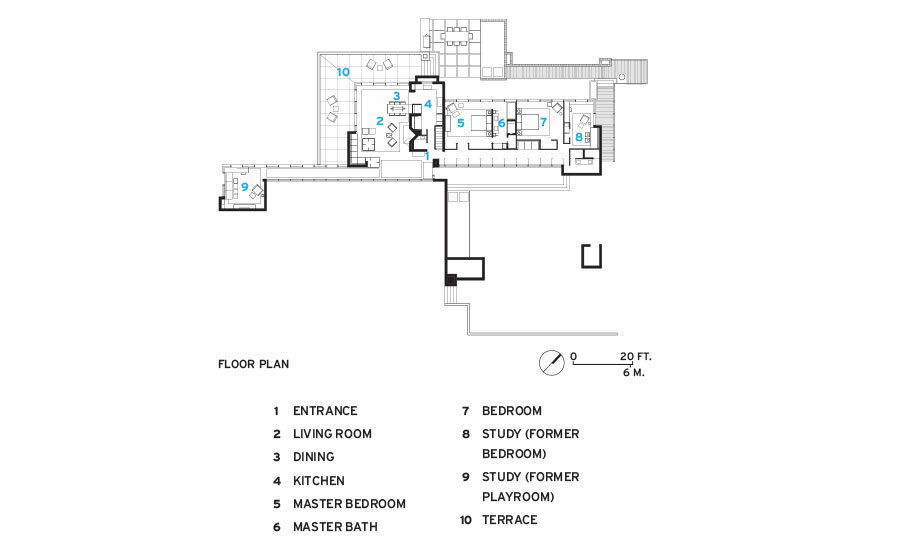
Image courtesy Eifler & Associates







Architects & Firms
In 1956, Frank Lloyd Wright said about an impossible client, “There can be but one Louis Fredrick . . . He does not know what he wants, nor what he does not want. He has cost us more pains in time and money . . . than he can ever repay. If ever he gets a house, he will be the architect—and God help both him and the house.” Oddly, Wright was addressing that complaint to the client himself.
Additional Content:
Jump to credits & specifications
And, even more surprisingly, the following year, Wright actually built a home for Fredrick and his family, in Barrington Hills, Illinois, an affluent area 40 miles northwest of Chicago. It’s not clear, however, that the Hungarian-born contract-interiors designer and onetime boxer became less of a nightmare client. For the same site, he’d already had Wright develop two entirely different, construction-ready house designs (including a textile-block scheme)—and rejected both. Then he switched to another architect before circling back to Wright, who completed the Lewis B. Fredrick House for move-in in 1958. In the process, funds ran short, leaving most of Wright’s custom furniture unrealized. And, when the architect died a year later, his fee remained partially unpaid. So, that history—combined with Fredrick’s sense of privacy—may explain why this striking project never got published. But now it’s emerged from extensive renovations by Chicago-based Eifler & Associates (E&A), commissioned by an owner who wanted to include many of the previously unexecuted elements and is willing to share the results more widely.
Wright’s final design for the wooded 10-acre site was (unbeknownst to Fredrick) a hand-me-down from a canceled Michigan project. Modifications for Fredrick included substituting Cranbrook brick for stucco cladding on the low-slung, 2,650-square-foot single-story house, which sits high on a hillside. A 34-foot-long daylit gallery connects the playroom (now a study) to the rest of the house, with its original three bedrooms, two and a half baths, and—like Wright’s other Usonian Houses—polished concrete floors with radiant heating. The purportedly modest and affordable “Usonians” often became pricey to build—and this one, at $100,000, was astronomically costly for its era. Fredrick lived there until his death, in 2002. His children later sold the property to an art collector, who—despite high aspirations—left it vacant and unmodified for 12 years. Finally, in 2016, real-estate developer David McArdle bought it.
Decades earlier, McArdle, with his wife, Joyce, had owned and renovated Wright’s 1901 F.B. Henderson House, in Elmhurst, Illinois. In 1989, they helped found the Frank Lloyd Wright Building Conservancy. And, in 1994, they commissioned a home from Wright disciple E. Fay Jones, right in Barrington Hills. “Yet we never got to see the Fredrick House,” says McArdle. “It’s not visible from the road, and the driveway is steep and private.” He finally got inside—and made his offer—the day it went on the market (listed at $795,000). “It was a wonderful time capsule—almost nothing had been done to it,” he recalls. “But that also meant it needed lots of work.” He approached Eifler, who’d renovated more than 20 Wright houses, including 15 Usonians, and impressed on him, the architect remembers, “that he wanted to do a bang-up job.”
The two-year renovation included restoring roofs, floors, and radiant heating, while borrowing square footage from an oversize secondary bedroom for a more generous master bath. E&A stripped Fredrick’s pink and green tints from the cabinetry, restoring natural color and luster to the interior’s ubiquitous Philippine mahogany. Now the house has geothermal heating and cooling, plus Wright’s custom furniture, most of it for the first time. The McArdles also mixed in contemporary pieces—notably by Nakashima, who’d created some of Fredrick’s original furnishings here. This spring, Eifler will build Wright’s freestanding stable (as a teahouse with garage space, since Usonian homes only have carports).
The owners, who also reside in Florida, moved in last June. “It’s been wonderful,” says McCardle. “If you’re lucky enough to live in a Wright house, you constantly see things you haven’t noticed before, even the play of light, or the way a small detail leads your eye. Such amazing thoughtfulness in the design. Everyone who steps inside says, ‘Oh, my God!’ ”
CreditsArchitect: Frank Lloyd Wright, 1957
Restoration architect: Eifler & Associates Architects — John Eifler, principal; Virginia Eby, interior
Lead carpenter: Jon Leck
Wood conservation/finishes: James Madsen, Fillmore Associates
Engineer: J&R Herra (mechanical)
Project manager: Deer Creek Construction Management |
SpecificationsMillwork Distinctive Millwork
Masonry Marion Masonry
Stone Vetter Stone
Roofing Cedar Roofing |

